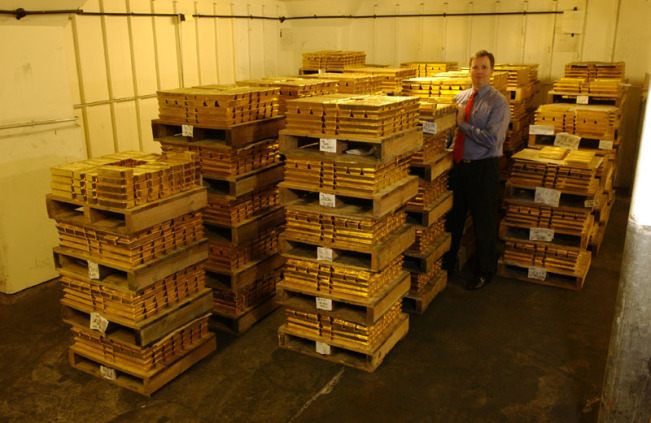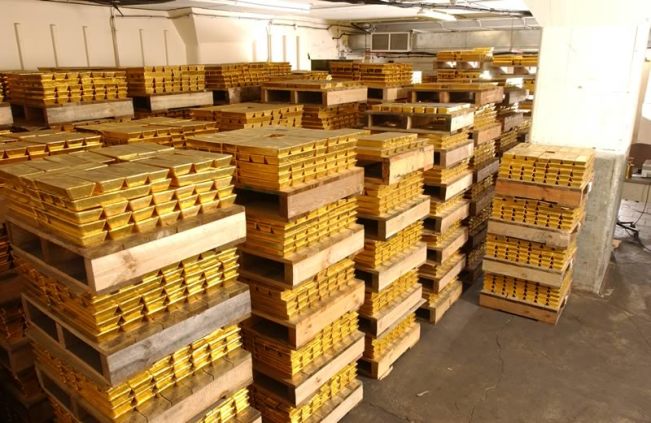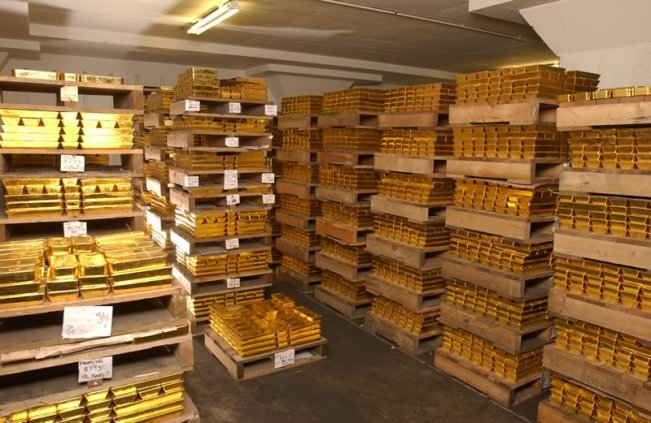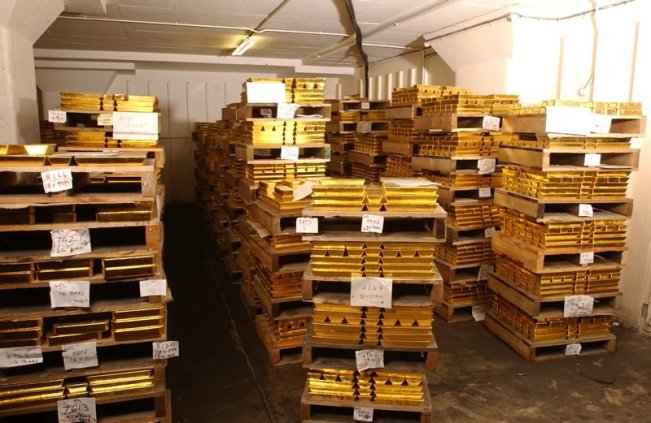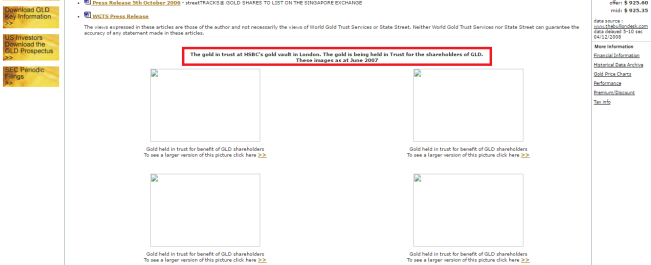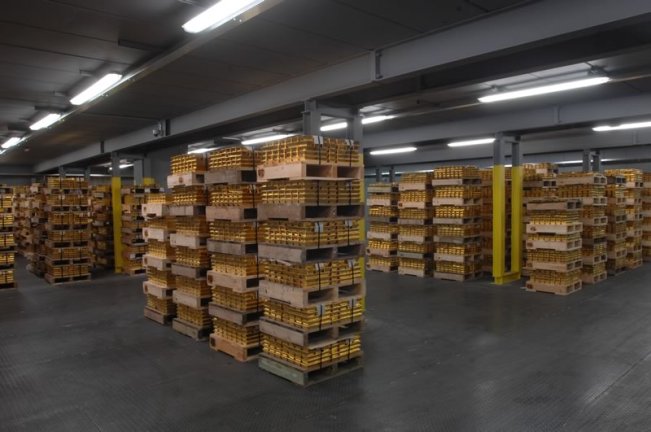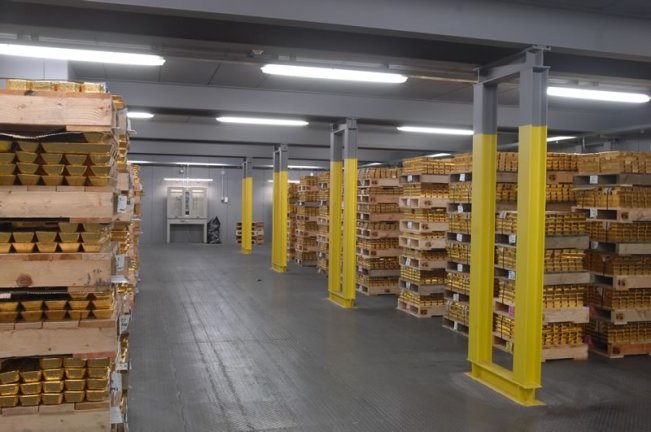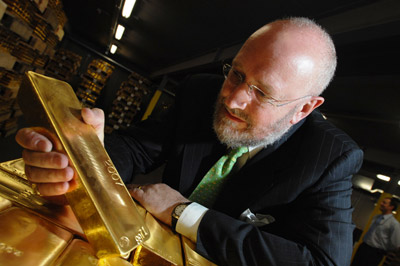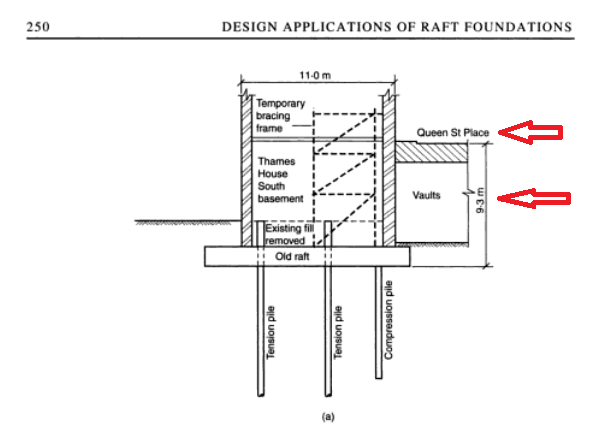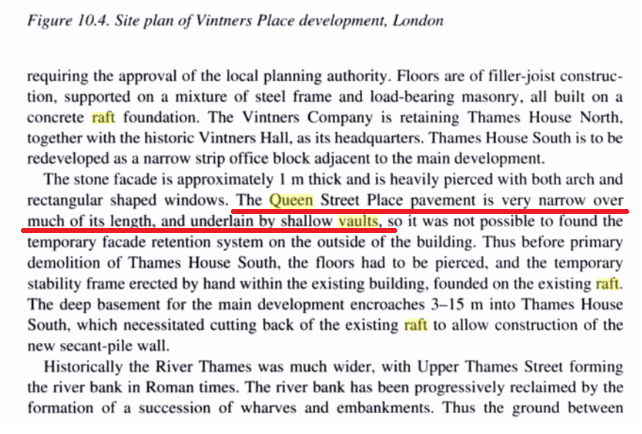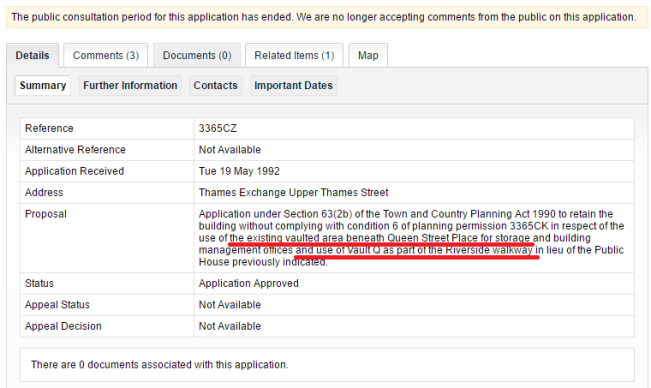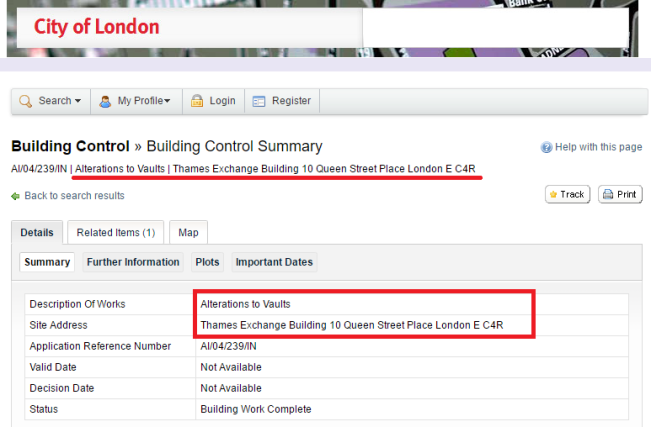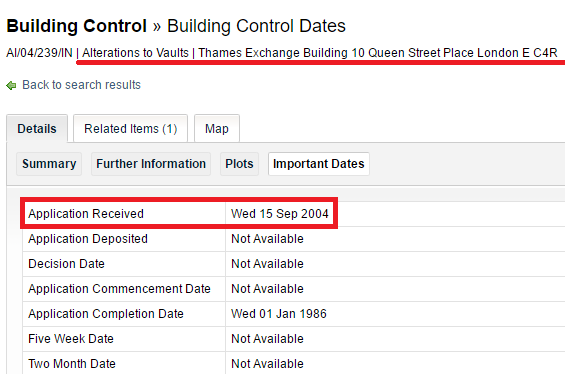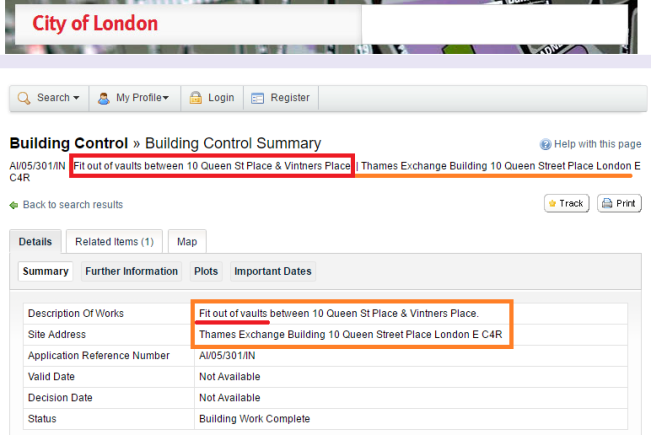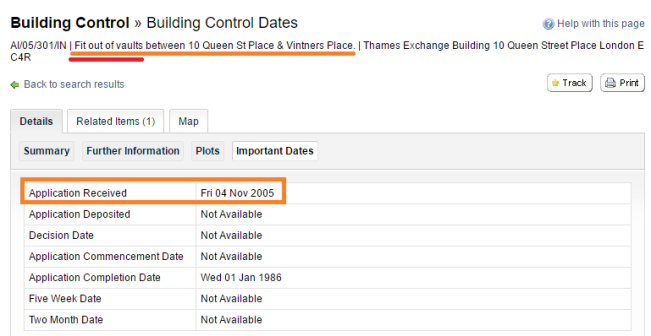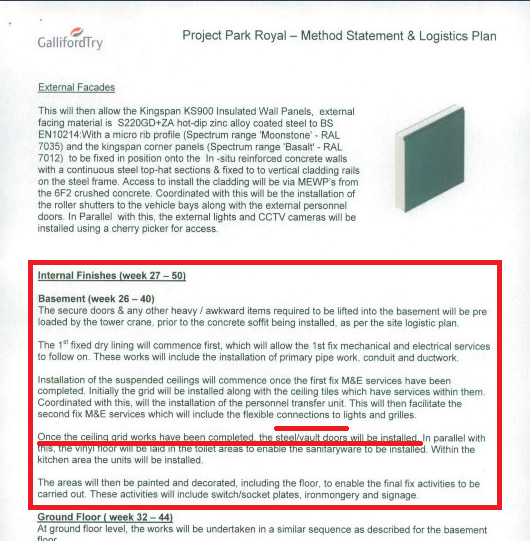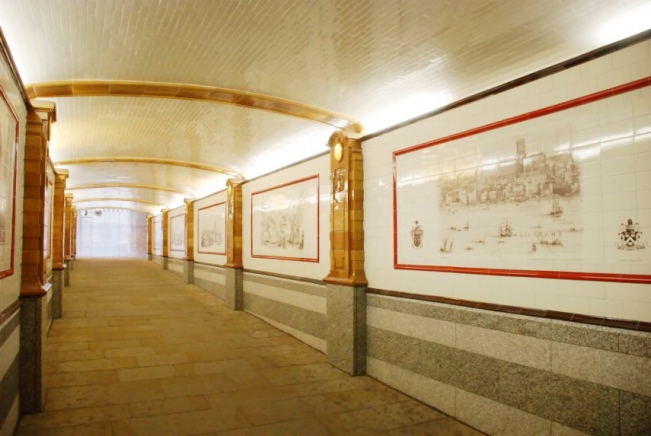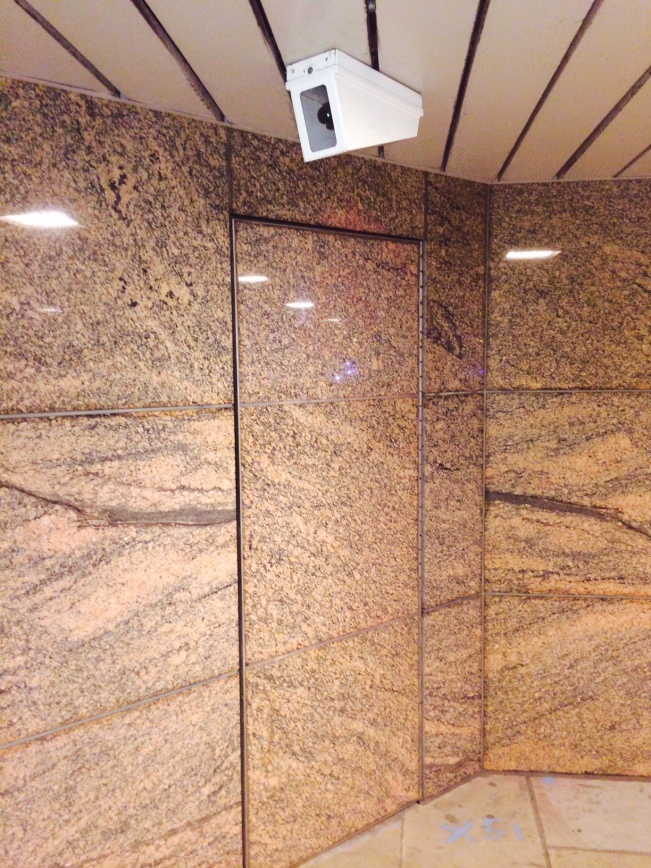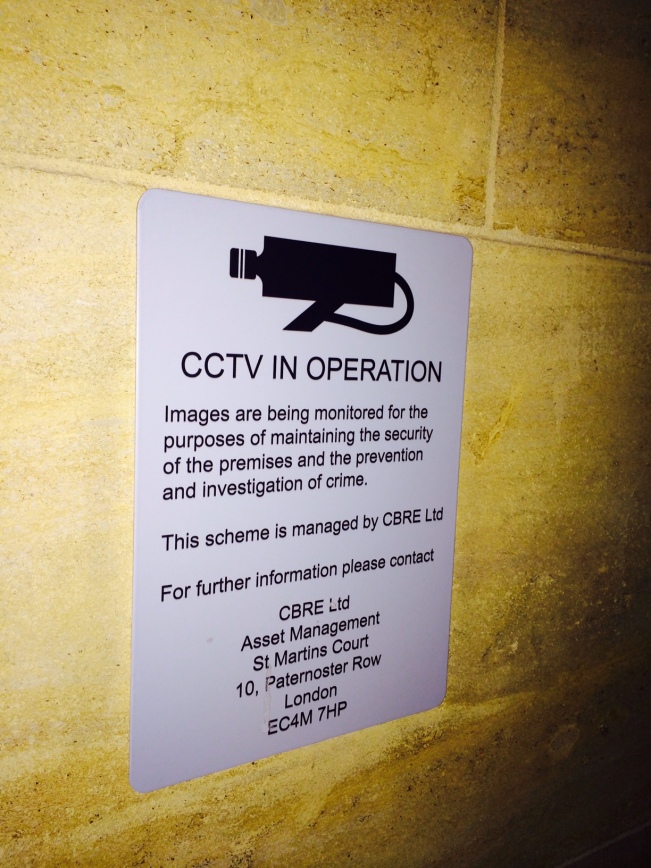HSBC’s London Vault: Is This Gold’s Secret Hiding Place?
HSBC’s main gold vault in London regularly comes under the media spotlight for a number of reasons. These reasons include:
a) the HSBC London vault stores a very large amount of gold on behalf of gold-backed Exchange Traded Funds, primarily the well-known SPDR Gold Trust (GLD)
b) along with the Bank of England vaults and JP Morgan vault, the HSBC vault is one of the 3 largest gold vaults in London
c) the location of the HSBC vault in London is not publicised and so the secrecy creates intrigue
d) HSBC every so often throws out some visual or audio-visual media bait about the vault, most famously in the case of CNBC’s Bob Pisani and his camerman and producer visiting and filming inside the actual vault
Despite all of the above, no one seems to have ever tried to figure out where this gold vault is actually located. Until now.
In some ways HSBC has done a very good job keeping the location of its London gold vault under wraps. The main challenge is where does one begin to look for a vault in London from scratch. At first it would appear that there is nothing in the public domain pointing to the HSBC vault location. This is not entirely true however. The gold bullion activities of HSBC in London stem from two companies that over time became part of the HSBC group. My approach was to start by thinking about which London locations HSBC used to be based at. I took this approach because it became obvious that the HSBC London gold vault being used was still a battered looking old vault space in 2004 and 2005, which was after the entire HSBC company had moved to its spanking new London headquarters in Canary Wharf by 2003.
In New York, the location of the HSBC Bank USA precious metals vault in Manhattan is well-known and is even listed in CFTC documents such as here. The vault is at 1 West 39th Street, SC 2 Level , New York, New York 10018 , which is the same building as 450 Fifth Avenue, which is the former Republic National Bank building that HSBC took over in 1999-2000. This Republic building at 450 Fifth Avenue, when it was being built, “had special vault requirements that reportedly added significantly to the project’s cost“. So its hard to see why HSBC makes such a big deal of not revealing its London vault location.
History of HSBC gold operations in London
In 1993, HSBC Holdings plc relocated its headquarters to London after having acquired Britain’s Midland Bank the previous year. Midland in turn had fully acquired Samuel Montagu in 1974 to form Midland Montagu. Samuel Montagu & Co was a City of London bullion broker, and one of the 5 original gold fixing members of the London Gold Fixing, and in turn, Midland Montagu was also a Gold Fixer. In 1999, HSBC began using the name ‘HSBC’ for the Gold Fixing seat of Midland Montagu.
Between 1999 and 2000, HSBC completed the acquisition of Republic National Bank of New York. Republic National Bank of New York had been a big player in the world gold markets, and in 1993, Republic National had bought one of the London Gold Fixing seats from Mase Westpac, meaning that from 1993 both Republic National and Midland Montagu held Gold Fixing seats, and that HSBC ended up with 2 of the 5 Gold Fixing seats. Therefore, in 2000, following the Republic National takeover, HSBC in London sold one of its newly acquired seats to Credit Suisse.
I also have always thought that the HSBC vault is in central London, and not in some far-flung outer London location. The LPMCL website (www.lpmcl.com) still displays text that says that the bullion clearer’s vaults are in ‘central London locations’:
“The five London bullion clearing members each maintain confidential secure vaulting facilities within central London locations, using either their own premises, or those of a secure storage agent…"
Anyone who knows London will understand that ‘central London’ refers to a small number of central districts, and not some broader inside the M25 (ring road) definition. Before moving to Canary Wharf in circa 2003, HSBC occupied a number of buildings clustered around the north bank of the River Thames, including 10 Lower Thames Street (the Banks’ Headquarters), 3 Lower Thames Street (St Magnus House), 10 Queen Street Place at the corner of Upper Thames Street (Thames Exchange – containing a trading floor), and Vintners Place (adjoined to Vintners Hall on the other side of Queen Street Place and Upper Thames Street).
HSBC Bank USA NA (London branch)
Until late 2014, the HSBC entity that was the custodian of the SPDR Gold Trust was “HSBC Bank USA NA (London branch)". NA means National Association. On 21 November 2014, effective 22 December 2014, the custodian for the SPDR Gold Trust switched from HSBC Bank USA, National Association to HSBC Bank plc.
HSBC Bank USA NA (London branch), until 2015, was also the HSBC entity that was listed as a member of London Precious Metals Clearing Limited (LPMCL) on the LPMCL website. See, for example, September 2009 imprint of LPMCL website. The next step is therefore to see where HSBC Bank USA NA (London branch) was formerly located.
The Financial Services Register (FSA Register) lists HSBC Bank USA, Reference number: 141298, effective from 24 January 2000, with a registered address of Thames Exchange, 10 Queen Street Place, London EC4R 1BE. Recalling the Republic National connection, the previous registered name for this entity was “Republic National Bank of New York", with the same address, effective from 18 December 1995 to 24 January 2000. The FSA Register entry also lists various well-known names of the HSBC gold world alongside this HSBC Bank USA entity, including Jeremy Charles, Peter Fava and David Rose.
Recalling the Samual Montagu / Midland Montagu connection to HSBC, an entity called Montagu Precious Metals is also listed with an old address at “2nd Floor, Thames Exchange, 10 Queen Street Place, London EC4R 1BQ.
An old gold information website called GoldAvenue from the year 2000, written by Timothy Green, also lists HSBC Bank USA (London branch) address as:
HSBC Bank USA
London branch
Thames Exchange
10 Queen Street Place
London EC4R 1BQ
That same Gold Avenue web page also correctly listed the HSBC New York vault address as:
HSBC Bank USA
452 Fifth Avenue
New York, NY 10018
which is the same building as West 39th Street, New York, in Manhattan.
The precursor to the SPDR Gold Trust was called Gold Bullion Ltd, a vehicle set up by Graham Tuckwell, promoted by the World Gold Council, and listed on the Australian Stock Exchange. Gold Bullion Ltd’s first day of trading was 28th March 2003. Following Gold Bullion Ltd’s launch, the SPDR Gold Trust (GLD) was then launched in 2004, but originally it was called STREETracks Gold Shares, and it even had another former working title of ‘Equity Gold Trust’ in early 2004.
A May 2003 Marketwatch article about Gold Bullion Ltd and the early incarnation of the SPDR Gold Trust (Equity Gold Trust) can be seen here, and a speech by Graham Tuckwell about Gold Bullion Ltd to the LBMA annual conference in Lisbon in 2003 can be seen here. Most importantly, an early draft Prospectus of Gold Bullion Ltd (in MS Word), dated 10 February 2003, lists the Custodian of Gold Bullion Ltd as:
CUSTODIAN BANK
HSBC Bank USA
Thames Exchange
10 Queen Street Place
London EC4R 1BQ
Therefore, Thames Exchange goes to the top of the list for further consideration, as does it’s neighbour Vintner’s Place. Thames Exchange and Vintners Place were both HSBC buildings and both buildings are situated right across the road from each other, with Queen Street Place literally bisecting the 2 buildings. Queen Street Place is also the road that acts as the approach road to Southwark Bridge, with the 10 Queen Street Place building and the Vintners Place building literally creating a canyon either side of the road.
You will see below why Queen Street Place is interesting. Queen Street Place is very near the Bank of England and is in the City of London, so it’s under City of London Police protection. It’s also very near the River Thames, as is the JP Morgan London vault. To get to the Bank of England from Queen Street Place, you literally walk a mintute north up Queens Street, and then a few minutes north-east along Queen Victoria Street and you’re at the Bank of England.
An official HSBC letter-headed note documenting the Thames Exchange address and proving HSBC occupied this building can be seen here. Similarly, an official letter-headed note documenting the Vintner’s Place address, and proving that HSBC occupied that building can be seen here.
HSBC moves out of the City of London – 2002/2003
A Property Week article from 20 April 2000, titled “JLL to mastermind HSBC’s City exodus“, covered the huge HSBC move out of the City to Canary Wharf in the early 2000s:
“HSBC has stepped up its retreat from the City of London by instructing agents to open negotiations on the disposal of its outstanding City liabilities.
In one of the most hotly contested pitches of last year, Jones Lang Lasalle has beaten rivals to secure the lead role as strategic adviser for the bank’s relocation to Docklands [Canary Wharf] in 2002.
In addition to JLL, the bank has instructed another seven firms to mastermind the disposal of its 121,000 sq m (1,302,445 sq ft) City portfolio."
“HSBC has ruled out acquiring freehold or long-leasehold interests and has instructed agents to negotiate the best surrender or assignment of the occupational leases on its 12 City buildings."
“Morgan Pepper is advising on HSBC’s 17-year lease at Thames Exchange, 10 Queen Street Place, EC4. The Scottish Amicable building is currently under offer to Blackstone Real Estate Advisors for £73m.
Insignia Richard Ellis, Chapman Swabey, Strutt & Parker and Wright Oliphant have positions on the bank’s remaining interests in Vintners Place EC3; Bishop’s Court at Artillery Street, and HSBC’s 37,160 sq m (400,000 sq ft) office complex at St Magnus House and Montagu House.
By the time STREETracks Gold Trust (the original name for the SPDR Gold Trust) was launched in 2004, HSBC Bank USA’s address had moved to HSBC’s new headquarters in Canary Wharf, in the Docklands, east of the City of London. By early 2003, Equity Gold Trust also listed the HSBC custodian with the Canary Wharf address.
An article by engineering company Arup HSBC Headquarters – Canary Wharf – Arup), describing the new HSBC Canary Wharf building, dated 21 April 2004 stated:
“The phased occupation of the [Canary Wharf] building was completed in February 2003 when the last of over 8000 staff moved in, with HSBC Group Chairman Sir John Bond officially opening the building as the Group’s new head office on 2 April 2003."
However, the old HSBC gold vault did not ‘move’ at the time the rest of HSBC moved lock, stock, and barrel to Canary Wharf between 2002-2003. In fact, the HSBC vault remained where it was in a slightly rundown shabby space with cream-colored walls. See multiple photos of the vault space below. The HSBC vault did however transform from an ‘old’ vault into a ‘new’ vault sometime between 2006 to early 2007. My belief, which I’ll explain below, is that this vault didn’t move, it just received an extensive renovation.
A diagram of the HSBC headquarters in Canary Wharf where the whole London HSBC workforce moved to by early 2003 can be seen below. Notice the car parks in basements B2, B3 and B4. You can also read about the basement construction in the Arup document above. This is not the location for a beat-up old vault that can be seen in the below old gold vault shots. Besides, the vertical pillars/piles in the old and new HSBC vault are nothing like the huge structural pillars/piles found in the HSBC headquarters in Canary Wharf.
The pillars in the old HSBC vault photos are pillars that would be found in an old arched vault, while the support pillars in the new HSBC vault photos are those that would be found in relatively shallow spaces under a road, such as pillars/supports used in the cut and cover New York subway system.
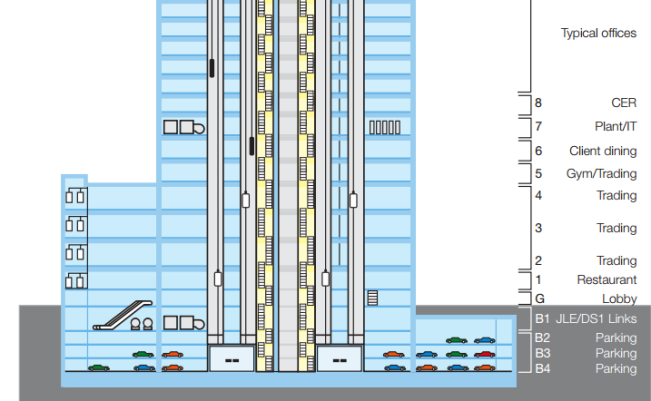
HSBC Gold Vault Photos
December 2004:
Here you can see an early gold vault photo of Graham Tuckwell, joint managing director of Gold Bullion Securities, and Stuart Thomas, managing director of World Gold Trust Services, in the ‘old’ HSBC vault in December 2004 checking a HSBC bar list:
Source: https://web.archive.org/web/20051125081854/http://streettracksgoldshares.com/images/DSC_0130_800.jpg
And another photo, taken at the same time, of Stuart Thomas in the vault in December 2004:
Notice the very old piping around the top of the walls.
Source:https://web.archive.org/web/20051125082702/http://streettracksgoldshares.com/images/dsc_0178_800.jpg
In fact, there are lots more photos of the inside of the ‘old’ vault on the StreetTRACKS website here https://web.archive.org/web/20060518124841/http://streettracksgoldshares.com/us/media/gb_media.php
June 2005:
See five photos below of vault in June 2005:
‘Old’ vault looks quite beaten with concrete pillars, old floor, old air conditioning unit, and awful decor, and some type of desk an chair and wiring on the very right hand side of the photo.
October 2005:
Managing Director Stuart Thomas, Director of Corporate Communications, George Milling-Stanley of World Gold Trust Services, and CFO and Treasurer James Lowe (wearing a gold tie) of World Gold Trust Services
6 more vault shots of gold bars stacked on pallets:
http://web.archive.org/web/20070109203025/http://streettracksgoldshares.com/images/DSC_0055_800.jpg
http://web.archive.org/web/20070110123058/http://streettracksgoldshares.com/images/DSC_0042_800.jpg
http://web.archive.org/web/20070110204026/http://streettracksgoldshares.com/images/DSC_0149_800.jpg
When the gold is stacked 6 pallets high, as in the above photo, it nearly reaches up to where the pillars start to broaden out. Recall for a moment the definition of a vault. A vault is any space covered by arches, or an arched ceiling over a void. This is why the Bank of England ‘vaults’ are called vaults, because in the old vaults of the Bank of England (before the Bank of England was rebuilt in the 1920s/1930s), the gold was stored in the arched vaulted basements. The pillars in the shots of this ‘old’ HSBC vault look like pillars/piles that are the lower parts of arches, since they taper outwards as they go higher and they are positioned in a grid like formation.
http://web.archive.org/web/20070111113411/http://streettracksgoldshares.com/images/DSC_0065_800.jpg
You can see how all the pallets of gold were located in a space with quite a lot of walls and chunky support pillars that broaden at the top (i.e. support pillars). Very similar pillars can be seen in old parts of the London Underground pedestrian tunnels, and also in the Vintner’s Hall wine vaults, which is next door to the vaults under Queen Street Place.
The NEW HSBC Vault 2007
“The gold in trust at HSBC’s gold vault in London. The gold is being held in Trust for the shareholders of GLD. These images as at June 2007"
2007 George Milling-Stanley and possibly a bearded Stuart Thomas – June 2007
George Millin-Stanley’s watch puts the time at 11:45am.
https://static.bullionstar.com/blogs/uploads/2016/04/dsc_0127_800.jpg
Milling-Stanley and 3 others – probably from State Street and BONY – June2007
https://static.bullionstar.com/blogs/uploads/2016/04/dsc_0102_800.jpg
New vault – wide angle shot 2007
https://static.bullionstar.com/blogs/uploads/2016/04/dsc_0018_800.jpg
2nd wide angle new vault shot 2007
https://static.bullionstar.com/blogs/uploads/2016/04/dsc_0005_800.jpg
As it turns out, there are vaults beneath the road under Queen Street Place, between 10 Queen Street Place (Thames Exchange) and Vintners Place, and these vaults were renovated during the period that would coincide with the HSBC London gold vault transforming from an ‘old’ vault to a ‘new vault’.
Southwark Bridge and The Queen Street Place Vaults
Southwark Bridge is a bridge over the River Thames connecting the City of London (financial district) on the north bank of the river, to the area of Southwark on the south bank. The first Southwark Bridge (Queen Street Bridge) opened in 1819 and was an arched bridge with “vaults under the north abutment of the bridge“. There is also a reference to the vaults under Queen Street Place in a 1908 Corporation of London Record Office record.
A second bridge, the current Southwark Bridge, replaced the earlier bridge, and it opened in 1921.
A book titled ‘Design Applications of Raft Foundations‘, when discussing the development that became Vintners Place, mentions the vaults under Queen Street Place and shows that the vault space begins maybe 2.0 metres under the roadway, and with the vault space height being about 5 metres high which looks a very similar height to both the ‘old’ and ‘new’ HSBC vault spaces.
In fact, there were up to 17 vaults under Queen Street Place judging by a planning application from 1992 which listed a Vault Q (assuming Vaults A – Q), and the application said that the vaults had been used for storage.
Alterations to Vaults under Queen Street Place
Keeping in mind that the ‘old’ HSBC gold vault became a ‘new’ HSBC gold vault sometime in 2006, or early 2007, then the following, in my view, becomes highly relevant. In September 2004, a building control planning application was submitted to City of London planning department for Alterations to Vaults in the Thames Exchange building at 10 Queen Street Place. See link for the application. See screenshots also.
Fit Out of Vaults under Queen Street Place
Following this in November 2005, another building control planning application was received by the City of London planning department for “Fit out of Vaults between 10 Queen Street Place and Vintners Place“. See link below and also screenshots.
Thames Exchange – 10 Queen Street Place
Blackstone bought Thames Exchange from Scottish Amicable in 2000 while it was still being leased to HSBC. HSBC then surrendered the lease of the building when it moved to Canary Wharf in 2003. Blackstone then renamed Thames Exchange to 10 Queen Street Place and began renovating it while leasing it to City law firm SJ Berwin for its new London headquarters. However, SJ Berwin only moved its London headquarters from Gray’s Inn Road to 10 Queen Street Place sometime between February and April 2006, so the renovations appear to have gone on during 2003-2005. Norwich Property Trust purchased 10 Queen Street Place from Blackstone in 2006, after it had been renovated. Notably, Norwich retained TFT Consultants to inspect 10 Queen Street Place. TFT Consultants states in a case-study on its website that:
“We inspected this prominent riverside mixed-use building including extensive vaults underneath Southwark Bridge approach road and prepared a TDD report for Norwich Property Trust."
The Plans of the Vaults under Queen Street Place
Detailed plans of the vaults under Queen Street Place before and after the ‘Alterations’ and ‘Fit Out’ can be seen here ( Vault Plans – Before 10 Queen Street Place – Vaults – Lower Ground Floor Plan – Before alterations) and here (Vault Plans – Proposed 10 Queen Street Place – Vaults – Lower Ground Floor Plan – After alterations). Both sets of plans were drawn up by Hurley, Robertson Architects. Click on the links to bring up the actual pdf files of the full plans.
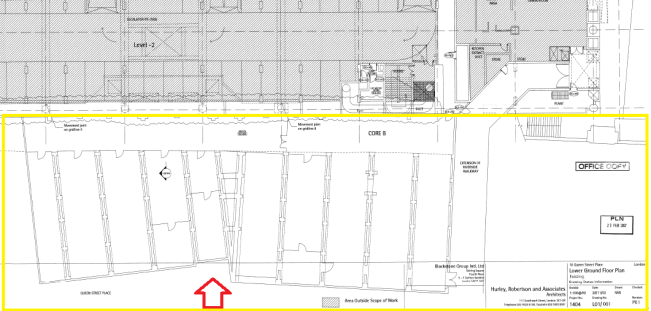
And more zoomed in. Notice all of the individual vaults and doors, and all of the walls with rows of pillars marked between the walls.
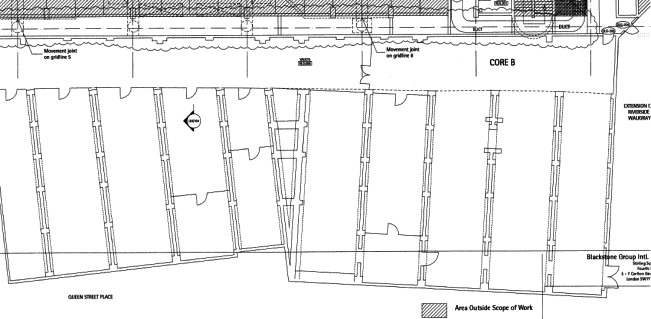
Compare the above plans to the ‘proposed’ plans. In the proposed plans, which are revision C08 dated 06 April 2006, all of the individual vaults have been removed by removing all the doors and walls, leaving just rows of pillars, and beams (given that it’s a top-down view looking down).
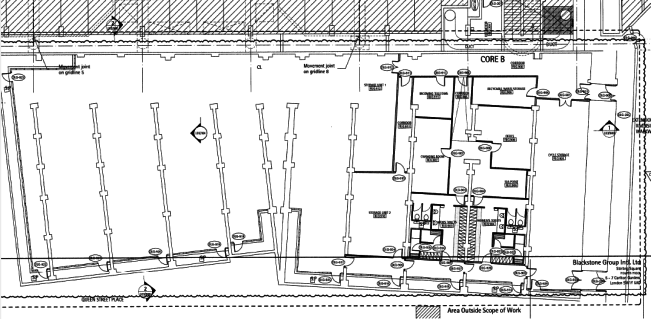
You can see the changes a bit more clearly in the following slightly zoomed in version. Notice the facilities added on the right, such as toilets, kitchen, changing rooms, office, telecoms room etc, and also the rows of supports/ pillars on the left hand side, which is about 7 rows of supports / pillars in the open space, 5 of which run at the same angle, then there is a V shape where the pillars then run at a different angle.
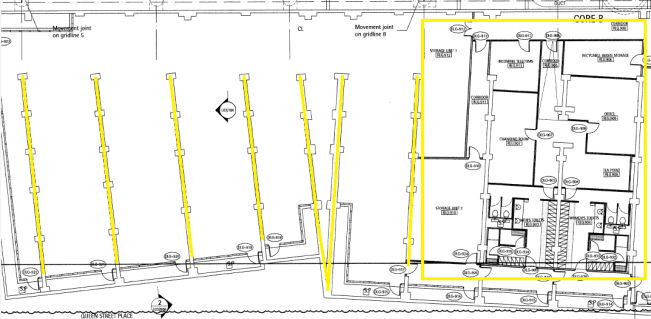
Anyone who has the inclination, given these sets of plans of the vaults under Queen Street Place, please check back over the photos of the ‘old’ HSBC vault and ‘new’ HSBC vault and decide for yourself if the photos in the ‘old’ cramped vault with the pillars and cream wall is reminiscent of the pre-alteration plans above. Likewise, decide for yourself if the ‘new’ HSBC London gold vault with the open plan design and layout of vertical steel support columns looks like the plans above of the ‘proposed’ alterations and ‘Fit Out’ of the vaults under Queen Street Place.
When G4S built its subterranean gold vault in Park Royal, London in 2013 / 2014, it fitted it out the area beside the vault with toilets and a kitchen – See second last sentence in red box below from the G4S building contractor document. Because, if you are working down in a vault all day, there will need to be toilets and a kitchen area, as well as changing rooms, phones and desktop computers etc. For background to G4S vault, see “G4S London Gold Vault 2.0 – ICBC Standard Bank in, Deutsche Bank out“.
The Pisani Files – “This is it folks, this is the Motherlode!"
Now we come to the Bob Pisani videos that were filmed by CNBC in the HSBC London gold vault in 2011. I say videos in plural because there are 4 video segments, and actually 5 segments in total including a trailer. The videos are quite exciting and fast-paced but frustrating because the camera is quite shaky and moves around rapidly for a lot of the vault segments, possibly on purpose. The background music is quite catchy also (at first).
1. The Motherlode
The first video is on a CBNC web page and embedded in an article titled “Gold’s secret hiding place”, however the video is titled “Gold Rush – The Mother Lode". Its dated Wednesday, 31 Aug 2011 with a byline of “CNBC’s Bob Pisani recently got an exclusive inside look at the HSBC gold vaults in London, where the gold for the SPDR Gold Trust (GLD) is stored." The video is 4:55 mins long, and introduced by Pisani from the New York studio. The vault shots begin at 1:18, and interestnigly, at 0:40 mins, the camera is in a vehicle travelling down Lower Thames Street.
http://www.cnbc.com/id/44343442
2. Gold’s Secret Hiding Place
Let’s call this 2nd video “Gold’s Secret Hiding Place". This version, which is different to the Motherlode, is on YouTube. I’m not sure of the official segment name. This version is 5:06 mins long, and Bob says the vault is “in a super-secret location only known to a few people”. This is also the version where Bob hands in his cellphone and travels in a blacked-out vehicle saying “we have no idea where we’re going. We only know our final destination. The vault!"
There is a neat online app called Pause House which allows you to look at any YourTube clip frame-by-frame, and can be used on the above clip for those who want to get a good look at the vault interior. (Pause House).
3. The Third version
Lets call this the Third version. Its 2:43 mins long. Pisani starts on Waterloo Bridge on the River Thames and he points towards Westminster Bridge (the exact opposite direction to Southwark Bridge). Then he is in the blacked-out vehicle, and then in the vault from 1:04 mins. At this stage the music might be annoying, so luckily, there is no background music when Bob talks in the vault.
4. Inside the Secret Vault
This clip is 2:42 mins long and is dated Thursday, 8 Mar 2012 with a byline of “CNBC’s Bob Pisani gets unprecedented access inside the largest private gold reserve in the world." Its slightly similar to version 3 above
http://video.cnbc.com/gallery/?video=3000077579
5. Version 5 is just a 31 second trailer about the CNBC 2011 gold series, published in March 2012, with gold vault footage only appearing for a few seconds.
https://www.youtube.com/watch?v=gUSqbqYOnRY&feature=youtu.be
2005 vs 2011
There is one sentence in both “Motherlode" and “Gold’s Secret Hiding Place" that I consider very interesting. And it relates to the ‘old’ and ‘new’ vaults. What Bob Pisani says has obviously been told to him by someone at HSBC, since he would not know anything about the vault in advance.
At 3:37 mins in Motherlode, Pisani says “In 2005, there was less than 200 tonnes of gold here, now there’s 6 times as much“.
At 4:05 mins in Gold’s secret hiding place, Pisani says “In 2005, there was less than 200 tonnes of gold in this vault backing the GLD. Now there’s 6 times as much."
Pisani is essentially saying, probably without realising, that it is the same vault. i.e. that the vault in 2005 is the same vault as in 2011. However, given that the vault in 2005 was the ‘old’ vault, and that the vault in 2011 was the ‘new vault’, this suggests that it is the same space, and that the vault space was just renovated. It therefore supports the view that the vaults under Queen Street Place are a very strong candidate to be the HSBC London Gold Vault that stores the GLD gold and the ETF Securities gold.
Fruiterers Passage
You might have spotted above that one of the existing vaults under Southwark Bridge was turned into a riverside walkway. This was probably vault Q, which looked to be the vault nearest the river. This walkway runs under the beginning of the abutment on the north of SouthWark Bridge and is called the slightly humorous name ‘Fruiterers Passage’. The Passage was opened circa the year 2000 (and named after the Worshipful Company of Fruiterers), and is ornately tiled with ceramics, even around its pillar enclosures. Take a look at a photo of Fruiterers Passage and compare it to a photo of the new ‘HSBC’ gold vault that features the yellow-painted steel support pillars. The dimensions and spacings of the pillars in both photos look very similar, even identical.
A video walk-through (2:45 mins) of Fruiterers Passage can be seen here. The first 20-30 seconds shows Southwark Bridge, and then the walk through the Passage begins:
Although there are lots of security cameras around the City of London, the cameras in Fruiterers Passage and security warnings near the entrance to the Passage seem particularly explicit.
Size Matters
A MarketWatch article from 11 January 2008 quoted George Milling-Stanley as saying that the vault was sizable but “not quite as big as a cricket pitch." On another occasion, Milling-Stanley used another sporting analogy and described the ‘new’ vault as “about the size of a football field“. Can a sporting analogy (or two) help determine the size of the HSBC London gold vault? Possibly, but it’s not as clear-cut as you might think.
Notwithstanding that a ‘cricket pitch’ is the (smallish) 22 yard strip between the wickets, the quotation was presumably referring to a ‘cricket field’. However, there is no standard shape of a ‘cricket field’, let alone standardised dimensions, since the ICC rules only state that the field can be circular or oval with a variable diameter of between 450 and 500 feet on the ‘long’ side (sometimes giving 16,000 sq yards). Regarding Milling-Stanley’s ‘football field’, analogy, it’s not clear whether this analogy was intended for a US audience or non-US audience. So it could mean ‘American’ football, or soccer or rugby.
In soccer, there is no standard size ‘field’. The sidelines (touch lines) have to be between 100 and 130 yards (110 to 120 yards for international matches), while the goal lines (end lines) must be between 50 and 100 yards (70 to 80 yards) in international matches. This could result in over 7000 sq meters or over 1.75 acres. The American football field is thankfully standardised, being 120 by 53.33 yards or 6400 sq yards.
Overall, Milling-Stanley’s descriptions give a flavour for permissible dimensions, but based on Bob Pisani’s video tour, I see the vault as a rectangular space but not quite as big as a soccer pitch. So lets look at the space in Google Earth. I’ve just added a yellow rectangle for illustrative purposes to show where the vaults under Queen Street Place are located.
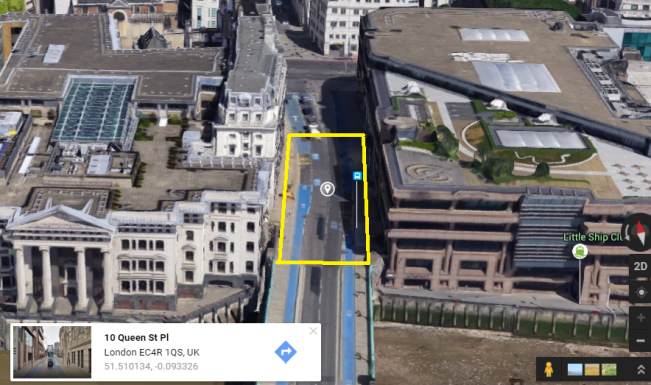
See also some cross-sectional plans that were part of the 2004 Blackstone Thames Exchange planning applications (Cross Section width 10 Queen St Place – from river view and Cross Section length 10 Queen St Place).
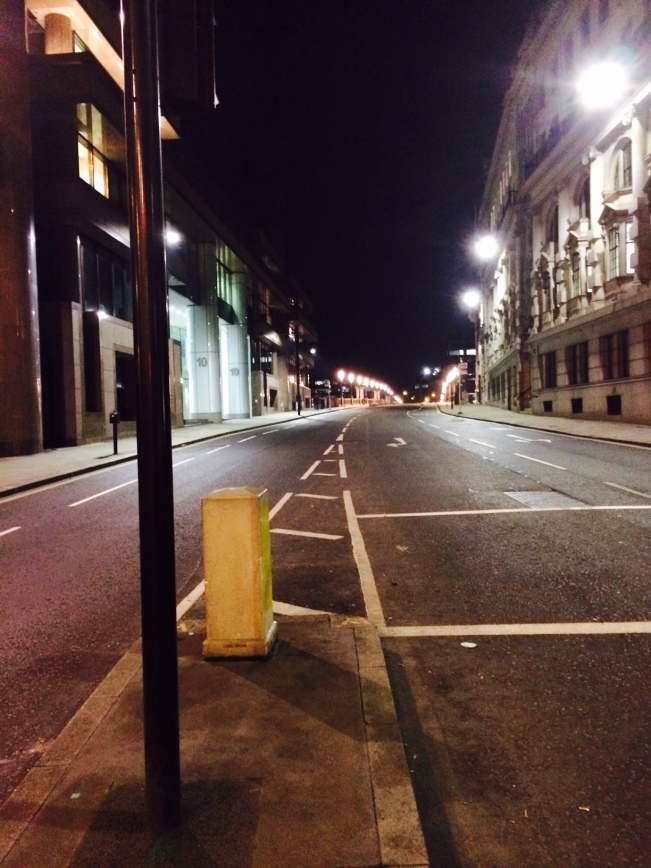
The Marketwatch January 2008 article also said that the HSBC vault was “located on the outskirts of London" but how would the journalist know this since the same article also said that “a spokeswoman for HSBC declined to provide vault details, citing security policies". As financial journalists mostly repeat what is told to them, I think this “located on the outskirts of London" bone was thrown out as a red-herring, and means the exact opposite.
Conclusion
At its peak holdings in December 2012, the SPDR Gold Trust stored 1353 tonnes of gold. Some observations from looking at the vault space in the Pisani videos and from talking to other people, are that:
a) the HSBC vault looks quite full in 2011, but it still looks like the space would be hard pushed to store the 1200 tonnes of gold that Pisani says were there
b) based on modelling the number of realistic-sized pallets that could conceivably fit into the Queen Street Place vault space (as per the vault plans), it also seems that it would be hard pressed to store 1,200 tonnes, unless they were crammed in. And the pallets in the CNBC segments are not fully crammed in to the space.
Remember also that the 1200 tonnes of gold reference only referred to the SPDR Gold Trust holdings in mid-2011 around the time the CNBC video segment was filmed. See blue line in chart below (chart from www.sharelynx.com) for GLD holdings over its lifetime. HSBC is also the gold custodian for ETF Securities’ gold-backed ETF which held about 170 tonnes at the time of Pisani’s visit. That would be nearly 1,400 tonnes of gold just between the GLD and ETFS holdings, which would be about 228 piles of pallets stacked 6 high crammed in. Furthermore, that’s not even taking into account any gold holdings of other HSBC customers, and Pisani also says in the videos that HSBC confirmed to him that its vault also stores gold for a range of clients.
When GLD held 1353 tonnes in December 2012, this in itself would be 225 piles of pallets, each 6 high. ETFS held about 170 tonnes in December 2012 also, which would be another 28 piles of pallets stacked 6 high. If this location is the famous storage area for the SPDR Gold Trust then possibly during the boom times when GLD holdings peaked, the HSBC vault may not have been big enough to accommodate the GLD gold let any other gold. Which would mean that HSBC was storing GLD gold elsewhere such as at the Bank of England vault, or the JP Morgan vault, both very close to Queen Street Place. It would also mean that GLD sources new gold inflows from gold that is at the Bank of England, i.e. leased central bank gold.
Another point to consider is that if the vaults under Queen Street Place are the correct location for the HSBC vault, then where did the gold that was being stored there in late 2005 / early 2006 go to during the vault alterations? This would have been at least 200 tonnes of gold as of late 2005, rising to over 350 tonnes of gold by late 2006. As the Bank of England is literally up the road from Queen Street Place, moving it to the Bank of England vaults would be the most likely option during the renovation.
In summary, using publicly available information and evidence, I have described where I think the HSBC London gold vault may be located. Whether I am correct is another matter.
Popular Blog Posts by Ronan Manly
 How Many Silver Bars Are in the LBMA's London Vaults?
How Many Silver Bars Are in the LBMA's London Vaults?
 ECB Gold Stored in 5 Locations, Won't Disclose Gold Bar List
ECB Gold Stored in 5 Locations, Won't Disclose Gold Bar List
 German Government Escalates War On Gold
German Government Escalates War On Gold
 Polish Central Bank Airlifts 8,000 Gold Bars From London
Polish Central Bank Airlifts 8,000 Gold Bars From London
 Quantum Leap as ABN AMRO Questions Gold Price Discovery
Quantum Leap as ABN AMRO Questions Gold Price Discovery
 How Militaries Use Gold Coins as Emergency Money
How Militaries Use Gold Coins as Emergency Money
 JP Morgan's Nowak Charged With Rigging Precious Metals
JP Morgan's Nowak Charged With Rigging Precious Metals
 Hungary Announces 10-Fold Jump in Gold Reserves
Hungary Announces 10-Fold Jump in Gold Reserves
 Planned in Advance by Central Banks: a 2020 System Reset
Planned in Advance by Central Banks: a 2020 System Reset
 China’s Golden Gateway: How the SGE’s Hong Kong Vault will shake up global gold markets
China’s Golden Gateway: How the SGE’s Hong Kong Vault will shake up global gold markets






 Ronan Manly
Ronan Manly 0 Comments
0 Comments
